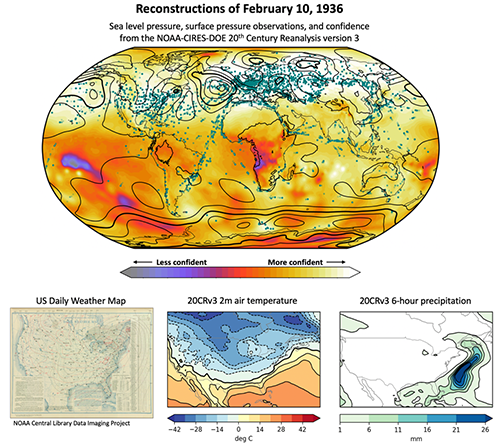Reconstructing the past 200 years of global weather
Key features of the climate system such as extreme weather events and phenomena are at the forefront of climate change research. “Reanalyses” provide a global reconstruction of past weather by combining first guesses from a modern numerical weather prediction system with actual observations using a process called “data assimilation”. By assimilating only surface pressure observations into an NOAA atmospheric model with prescribed sea surface temperatures, sea ice concentration, and radiative forcings, scientists from the University of Colorado Cooperative Institute for Research in Environmental Sciences (CIRES) at the NOAA Earth System Research Laboratory, collaborating with international partners, have generated global, 3-hourly estimates of the Earth system back to 1836 at about 75 km resolution, as well as internal estimates of confidence and uncertainty. This dataset recreates a 180-year history of temperature, precipitation, winds, humidity, and many other variables from below the land surface to the top of the atmosphere.

In a new article recently published in the Quarterly Journal of the Royal Meteorological Society, the authors explain how they generated the new Version 3 of the NOAA-CIRES-DOE 20th Century Reanalysis (20CRv3) by combining surface pressure observations with a modern numerical weather prediction system. The improvements over the previous version are illustrated by more consistent uncertainty estimates, smaller errors, and more accurate representations of storms. The dataset also assimilates millions more pressure observations, which represent an increase of 25% more observations per six hours in years prior to 1930. Many of these new observations were rescued and digitized by citizen scientists (e.g. www.oldweather.org), thus increasing users’ confidence in sparsely-observed regions of the globe such as the Arctic and Southern Hemisphere.
By providing 3-hourly estimates of the global weather over a 180-year period, the 20th Century Reanalysis allows researchers to study climate trends, historic storms, and how the frequency and quality of extreme events are changing over time. The dataset provides a crucial instrument-based link between paleo reconstructions and climate model projections, and can be used as verification for both. Older versions of this dataset have been used to study the 1816 Year Without a Summer, the 1930s Dust Bowl, the 1920-1930s Arctic warming, coastal defense planning, renewable energy, risk assessments for insurance and reinsurance purposes, disease tracking, El Niño Southern Oscillation and the Madden-Julian Oscillation.
Experiments reconstructing 1806-1835 are ongoing, but data for the years 1836-2015 from the new version 3 of the 20th Century Reanalysis are now available online at https://go.usa.gov/XTd. Ensemble statistics for many variables can be directly downloaded. Tools for generating plots online are also available.
Towards a more reliable historical reanalysis: Improvements for version 3 of the Twentieth Century Reanalysis system (Quarterly Journal of the Royal Meteorological Society)
Topics
- Weather
- Modeling
- Extreme Events
